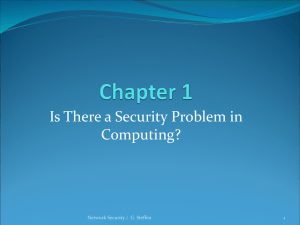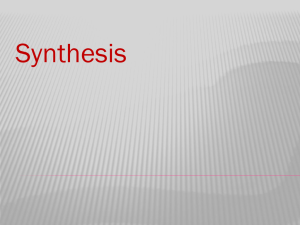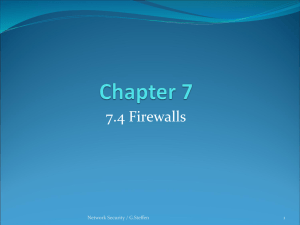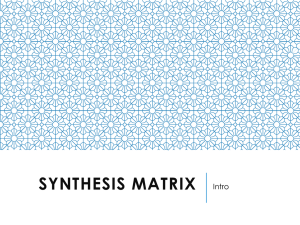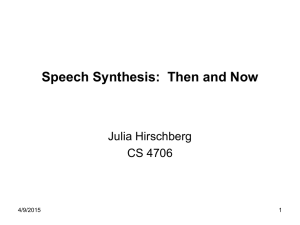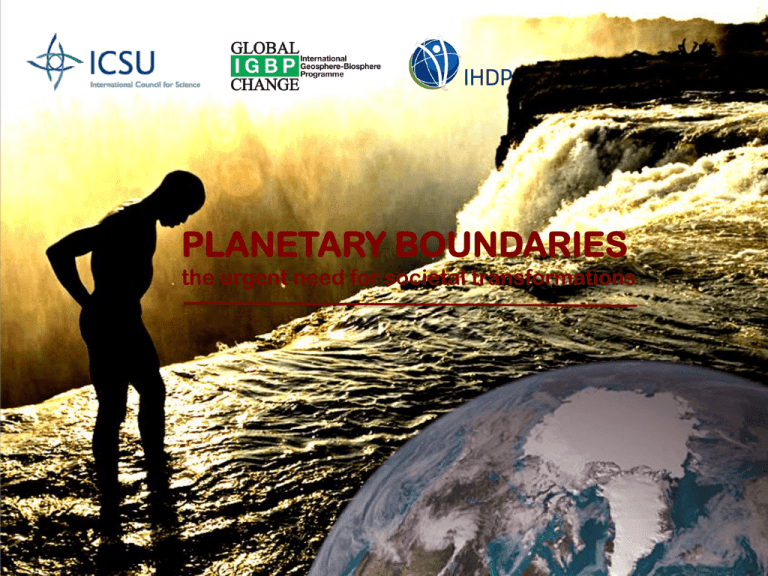
PLANETARY BOUNDARIES
the urgent need for societal transformations
PLANETARY BOUNDARIES
the urgent need for societal transformations
Planetary and societal risks
Why we need planetary stewardship
Professor Sybil Seitzinger
Executive Director
International Geosphere-Biosphere Programme
Antarctic ice core
Modern humans appear in Africa
Methane
Carbon
dioxide
Carbon
dioxide
Temperature
Methane
Loulergue, L.,et al Orbittal and millennial-scale features of atmospheric CH4 over the past 800,000 years, Nature, 2008.
Lüthi, D. et al High-resolution carbon dioxide concentration record 650,000-800,000 years before present Nature, 2008.
Antarctic ice core
Methane
Carbon
dioxide
Beyond natural boundaries
Loulergue, L.,et al Orbittal and millennial-scale features of atmospheric CH4 over the past 800,000 years, Nature, 2008.
Lüthi, D. et al High-resolution carbon dioxide concentration record 650,000-800,000 years before present Nature, 2008.
Human Development and
Glacial-Interglacial Cycling
First migration of
Modern humans
Migrations of fully
fully modern
arrive in
modern humans from
Beginning
humans out of Africa
Australia
South Asia to Europe of agriculture
Great European
civilizations:
Greek, Roman
The Holocene
Source: GRIP ice core data (Greenland)
And S. Oppenheimer,
”Out of ”Out
Eden”,
2004 2004
Source: GRIP ice core data (Greenland)
and S. Oppenheimer,
of Eden”,
IGBP Climate-change index
Global carbon dioxide
Global surface temperature
Arctic sea-ice minimum
Global sea level
IGBP Climate-change index
The Great Acceleration
– a planet under pressure
Population
US Bureau of the Census (2000) International database
IGBP synthesis: Global Change and the Earth System, Steffen et al 2004
Total real GDP
Nordhaus (1997) The economics of new goods. University of Chicago Press
IGBP synthesis: Global Change and the Earth System, Steffen et al 2004
Foreign direct investment
World Bank (2002) data and statistics
IGBP synthesis: Global Change and the Earth System, Steffen et al 2004
Damming of rivers
World Commission on Dams (2000)
IGBP synthesis: Global Change and the Earth System, Steffen et al 2004
Water use
Shiklomanov (1990) Global Water Resources
IGBP synthesis: Global Change and the Earth System, Steffen et al 2004
Fertiliser consumption
International Fertilizer Industry Association (2002)
IGBP synthesis: Global Change and the Earth System, Steffen et al 2004
Urban population
The State of the World’s Cities (2001)
IGBP synthesis: Global Change and the Earth System, Steffen et al 2004
Paper consumption
Pulp and paper international (1993)
IGBP synthesis: Global Change and the Earth System, Steffen et al 2004
Motor vehicles
Global environmental outlook (2000)
IGBP synthesis: Global Change and the Earth System, Steffen et al 2004
Telephones
Canning (2001) A database of world infrastructure stocks, 1950-95 World Bank
IGBP synthesis: Global Change and the Earth System, Steffen et al 2004
International tourism
World Tourism Organization (2001) Tourism industry trends
IGBP synthesis: Global Change and the Earth System, Steffen et al 2004
Shrimp farm production
IAnnual shrimp production as a proxy for coastal zone alteration. Sources: WRI (2003)
A guide to world resources, 2002-2004
IGBP synthesis: Global Change and the Earth System, Steffen et al 2004
Domesticated land
Amount of land converted to pasture and cropland. Source: Klein Goldewijk and Battjes (1997)
National Institute for Public Health and the Environment (RIVM). Bilthoven, Netherlands
IGBP synthesis: Global Change and the Earth System, Steffen et al 2004
Planetary response
Atmospheric CO2 concentration
Etheridge et al. Geophys Res 101: 4115-4128
IGBP synthesis: Global Change and the Earth System, Steffen et al 2004
Atmospheric N2O concentration
Machida et al Geophys Res Lett 22:2921-2925
IGBP synthesis: Global Change and the Earth System, Steffen et al 2004
Atmospheric CH4 concentration
Blunier et al J Geophy Res 20: 2219-2222
IGBP synthesis: Global Change and the Earth System, Steffen et al 2004
Northern hemisphere average surface
temperature
Mann et al Geophys Res Lett 26(6): 759-762
IGBP synthesis: Global Change and the Earth System, Steffen et al 2004
Ozone depletion
percentage total column ozone loss over Antarctica, using the average annual total
column ozone, 330, as a base. Image: J.D. Shanklin, British Antarctic Survey
IGBP synthesis: Global Change and the Earth System, Steffen et al 2004
Tropical rainforest and woodland loss
Loss of tropical rainforest and woodland, as estimated for tropical Africa, Latin America and South and
Southeast Asia. Sources: Richards (1990) In: The Earth as transformed by human action, Cambridge
University Press IGBP synthesis: Global Change and the Earth System, Steffen et al 2004
Natural climatic disasters
Decadal frequency of great floods (one-in-100-year events) after 1860 for basins larger than 200 000 km2 with
observations that span at least 30 years. Source: Milly et al. (2002) Nature 415:514-517 IGBP synthesis:
Global Change and the Earth System, Steffen et al 2004
Fisheries exploitation
Percentage of global fisheries either fully exploited, overfished or collapsed. Source:
FAOSTAT (2002) Statistical databases
IGBP synthesis: Global Change and the Earth System, Steffen et al 2004
Coastal zone nitrogen flux
Model-calculated partitioning of the human-induced nitrogen perturbation fluxes in the global coastal
margin for the period since 1850. Source: Mackenzie et al. (2002) Chem. Geology 190:13-32
IGBP synthesis: Global Change and the Earth System, Steffen et al 2004
Biodiversity loss
Mathematically calculated rate of extinction. Source: Wilson (1992) The diversity of life, the Penguin Press.
IGBP synthesis: Global Change and the Earth System, Steffen et al 2004
Great acceleration
IGBP synthesis: Global Change and the Earth System, Steffen et al 2004
“Our foot is stuck
on the accelerator
and we are
heading towards
an abyss.”
Ban Ki-Moon
A resilient Earth System
Reduced resilience – our precarious
predicament
Where are the thresholds
in the Earth system?
Photograph by Annie Griffiths Belt
National Geographic, February 2008 – © National Geographic Society, All rights reserved.
A safe operating space for humanity
Climate Change
Ozone
Depletion
Atmospheric
Aerosol Loading
Nitrogen
Ocean
Acidification
Phosphorus
Rate of
Biodiversity Loss
Land System
Change
Global
Freshwater Use
Chemical
Pollution
Rockström et al. 2009
2011 Global Risks Report
World Economic Forum
“The world is in no
position to face major,
new shocks.”
Planetary stewardship
- a safe operating space for humanity
Planetary Stewardship
2020
2030
2040
2050
New knowledge toward solutions
London, 26-29 March 2012
Planetary and societal risks
Why we need planetary stewardship
Professor Sybil Seitzinger
Executive Director
International Geosphere-Biosphere Programme
www.igbp.net
Sybil.seitzinger@igbp.kva.se


